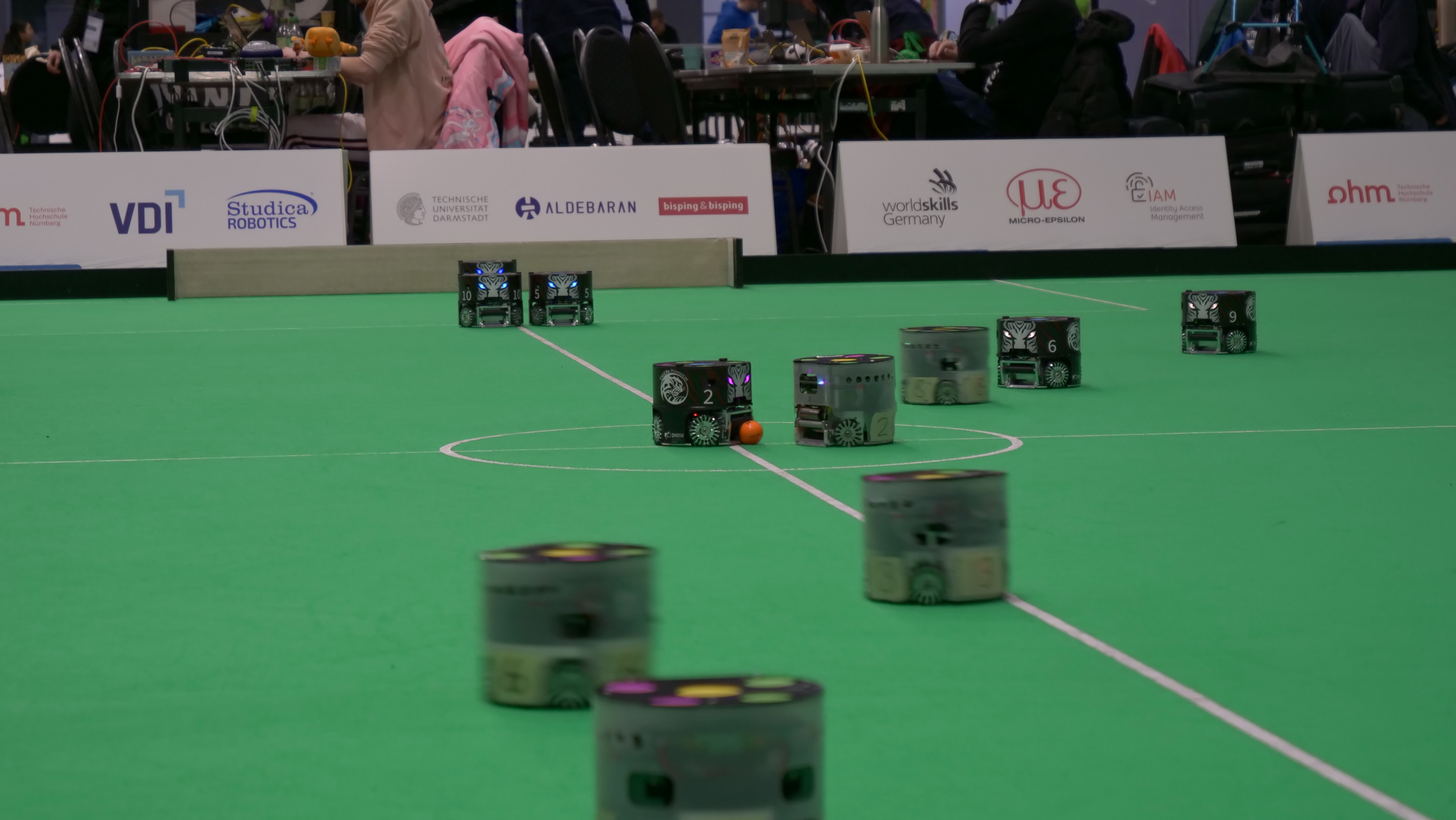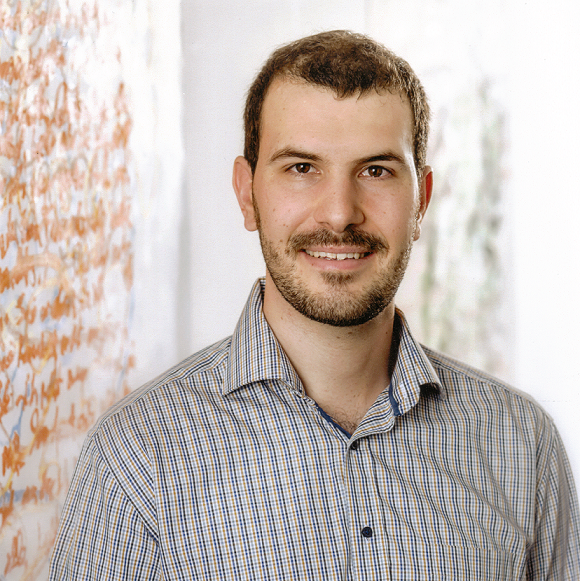 Kick-off in a Small Measurement League match. Picture credit score: Nicolai Ommer.
Kick-off in a Small Measurement League match. Picture credit score: Nicolai Ommer.
RoboCup is a global scientific initiative with the aim of advancing the cutting-edge of clever robots, AI and automation. The annual RoboCup occasion is because of happen from 15-21 July in Salvador, Brazil. The Soccer part of RoboCup contains various Leagues, with certainly one of these being the Small Measurement League (SSL). We caught up with Govt Committee member Nicolai Ommer to seek out out extra in regards to the SSL, how the auto referees work, and the way groups use AI.
Might begin by giving us a fast introduction to the Small Measurement League?
Within the Small Measurement League (SSL) now we have 11 robots per workforce – the one bodily RoboCup soccer league to have the complete variety of gamers. The robots are small, cylindrical robots on wheels and so they can transfer in any course. They’re self-built by the groups, so groups need to do each the {hardware} and the programming, and numerous issues need to work collectively to make a workforce work. The AI is central. We don’t have brokers, so groups have a central laptop on the discipline the place they’ll do all of the computation after which they ship the instructions to the robots in numerous abstractions. Some groups will simply ship velocity instructions, different groups ship a goal.
We now have a central imaginative and prescient system – that is maintained by the League, and has been since 2010. There are cameras above the sector to trace all of the robots and the ball, so everybody is aware of the place the robots are.
The robots can transfer as much as 4 meters per second (m/s), after this level it will get fairly unstable for the robots. They’ll change course in a short time, and the ball could be kicked at 6.5 m/s. It’s fairly quick and we’ve already needed to restrict the kick velocity. Beforehand we had a restrict of 8 m/s and earlier than that 10m/s. Nonetheless, no robotic can catch a ball with this velocity, so we determined to scale back it and put extra give attention to passing. This provides the keeper and the defenders an opportunity to really intercept a kick.
It’s so quick that for people it’s fairly obscure all of the issues which can be occurring. And that’s why, some years in the past, we launched auto refs, which assist loads in monitoring, particularly issues like collisions and so forth, the place the human referee can’t watch all the things on the identical time.
How do the auto refs work then, and is there multiple working on the identical time?
After we developed the present system, to maintain issues honest, we determined to have a number of implementations of an auto ref system. These impartial programs implement the identical guidelines after which we do a majority vote on the selections.
To do that we wanted a center part, so some years in the past I began this mission to have a brand new sport controller. That is the consumer interface (UI) for the human referee who sits at a pc. Within the UI you see the present sport state, you’ll be able to manipulate the sport state, and this part coordinates the auto refs. The auto refs can join and report fouls. If just one auto ref detects the foul, it received’t rely it. However, if each auto refs report the foul inside the time window, then it’s counted. A part of the problem was to make this all visible for the operator to know. The human referee has the final phrase and makes the ultimate choice.
We managed to determine two implementations. The intention was to have three implementations, which makes it simpler to type a majority. Nonetheless, it nonetheless works with simply two implementations and we’ve had this for a number of years now. The implementations are from two totally different groups who’re nonetheless energetic.
How do the auto refs cope with collisions?
We will detect collisions from the information. Nonetheless, even for human referees it’s fairly laborious to find out who was at fault when two robots collide. So we needed to simply outline a rule, and all of the implementations of the auto ref implement the identical rule. We wrote within the rulebook actually particularly the way you calculate if a collision occurred and who was at fault. The primary consideration is predicated on the rate – beneath 1.5m/s it’s not a collision, above 1.5m/s it’s. There may be additionally one other issue, regarding the angle calculation, that we additionally bear in mind to find out which robotic was at fault.
What else do the auto refs detect?
Different fouls embody the kick velocity, after which there’s fouls regarding the adherence to regular sport process. For instance, when the opposite workforce has a free kick, then the opposing robots ought to keep a sure distance from the ball.
The auto refs additionally observe non-fouls, in different phrases sport occasions. For instance, when the ball leaves the sector. That’s the commonest occasion. This one is definitely not really easy to detect, significantly if there’s a chip kick (the place the ball leaves the taking part in floor). With the digital camera lens, the parabola of the ball could make it appear to be it’s exterior the sector of play when it isn’t. You want a strong filter to cope with this.
Additionally, when the auto refs detect a aim, we don’t belief them utterly. When a aim is detected, we name it a “attainable aim”. The match is halted instantly, all of the robots cease, and the human referee can test all of the obtainable knowledge earlier than awarding the aim.
You’ve been concerned within the League for various years. How has the League and the efficiency of the robots developed over that point?
My first RoboCup was in 2012. The introduction of the auto refs has made the play much more fluent. Earlier than this, we additionally launched the idea of ball placement, so the robots would place the ball themselves for a free kick, or kick off, for instance.
From the {hardware} facet, the principle enchancment lately has been dribbling the ball in one-on-one conditions. There has additionally been an enchancment within the specialised expertise carried out by robots with a ball. For instance, some years in the past, one workforce (ZJUNlict) developed robots that would pull the ball backwards with them, transfer round defenders after which shoot on the aim. This was an sudden motion, which we hadn’t seen earlier than. Earlier than this you needed to do a cross to trick the defenders. Our workforce, TIGERs Mannheim, has additionally improved on this space now. However it’s actually troublesome to do that and requires numerous tuning. It actually is determined by the sector, the carpet, which isn’t standardized. So there’s a bit little bit of luck that your particularly constructed {hardware} is definitely performing properly on the competitors carpet.
The Small Measurement League Grand Closing at RoboCup 2024 in Eindhoven, Netherlands. TIGERs Mannheim vs. ZJUNlict. Video credit score: TIGERs Mannheim. You could find the TIGERs’ YouTube channel right here.
What are among the challenges within the League?
One large problem, and likewise perhaps it’s factor for the League, is that now we have numerous undergraduate college students within the groups. These college students have a tendency to go away the groups after their Bachelor’s or Grasp’s diploma, the workforce members all change fairly often, and that signifies that it’s troublesome to retain information within the groups. It’s a problem to maintain the efficiency of the workforce; it’s even laborious to breed what earlier members achieved. That’s why we don’t have giant steps ahead, as a result of groups need to repeat the identical issues when new members be part of. Nonetheless, it’s good for the scholars as a result of they actually study loads from the expertise.
We’re constantly engaged on figuring out issues which we are able to make obtainable for everybody. In 2010 the imaginative and prescient system was established. It was an enormous issue, that means that groups didn’t need to do laptop imaginative and prescient. And we’re at the moment establishing requirements for wi-fi communication – that is at the moment executed by everybody on their very own. We wish to advance the League, however on the identical time, we additionally wish to have this nature of having the ability to study, having the ability to do all of the issues themselves in the event that they wish to.
You actually need to have a workforce of individuals from totally different areas – mechanical engineering, electronics, mission administration. You additionally need to get sponsors, and you must promote your mission, get college students in your workforce.
Might you discuss among the AI components to the League?
Most of our software program is script-based, however we apply machine studying for small, delicate issues.
In my workforce, for instance, we do mannequin calibration with fairly easy algorithms. We now have a particular mannequin for the chip kick, and one other for the robotic. The wheel friction is sort of sophisticated, so we give you a mannequin after which we gather the information and use machine studying to detect the parameters.
For the precise match technique, one good instance is from the workforce CMDragons. One 12 months you possibly can actually observe that they’d skilled their mannequin in order that, as soon as they scored aim, they upvoted the technique that they utilized earlier than that. You could possibly actually see that the opponent reacted the identical manner on a regular basis. They had been in a position to rating a number of targets, utilizing the identical technique time and again, as a result of they realized that if one technique labored, they may use it once more.
For our workforce, the TIGERs, our software program may be very a lot primarily based on calculating scores for the way good a cross is, how properly can a cross be intercepted, and the way we are able to enhance the state of affairs with a selected cross. That is hard-coded typically, with some geometry-based calculations, however there’s additionally some fine-tuning. If we rating a aim then we observe again and see the place the cross got here from and we give bonuses on among the rating calculations. It’s extra sophisticated than this, in fact, however normally it’s what we attempt to do by studying through the sport.
Folks typically ask why we don’t do extra with AI, and I feel the principle problem is that, in comparison with different use instances, we don’t have that a lot knowledge. It’s laborious to get the information. In our case now we have actual {hardware} and we can’t simply do matches all day lengthy for days on finish – the robots would break, and so they have to be supervised. Throughout a contest, we solely have about 5 to seven matches in complete. In 2016, we began to file all of the video games with a machine-readable format. All of the positions are encoded, together with the referee choices, and all the things is in a log file which we publish centrally. I hope that with this rising quantity of knowledge we are able to truly apply some machine studying algorithms to see what earlier matches and former methods did, and perhaps get some insights.
What plans do you could have on your workforce, the TIGERs?
We now have truly received the competitors for the final 4 years. We hope that there can be another groups who can problem us. Our defence has probably not been challenged so now we have a tough time discovering weaknesses. We truly play in opposition to ourselves in simulation.
One factor that we wish to enhance on is precision as a result of there’s nonetheless some guide work to get all the things calibrated and dealing as exactly as we would like it. If some small element just isn’t working, for instance the dribbling, then it dangers the entire match. So we’re engaged on making all these calibration processes simpler, and to do extra automated knowledge processing to find out the very best parameters. Lately we’ve labored loads on dribbling within the 1 vs 1 conditions. This has been a extremely large enchancment for us and we’re nonetheless engaged on that.
About Nicolai

|
Nicolai Ommer is a Software program Engineer and Architect at QAware in Munich, specializing in designing and constructing strong software program programs. He holds a B.Sc. in Utilized Laptop Science and an M.Sc. in Autonomous Programs. Nicolai started his journey in robotics with Workforce TIGERs Mannheim, collaborating in his first RoboCup in 2012. His dedication led him to hitch the RoboCup Small Measurement League Technical Committee and, in 2023, the Govt Committee. Captivated with innovation and collaboration, Nicolai combines tutorial perception with sensible expertise to push the boundaries of clever programs and contribute to the worldwide robotics and software program engineering communities. |
AIhub
is a non-profit devoted to connecting the AI neighborhood to the general public by offering free, high-quality info in AI.

AIhub
is a non-profit devoted to connecting the AI neighborhood to the general public by offering free, high-quality info in AI.

Lucy Smith
is Managing Editor for AIhub.



